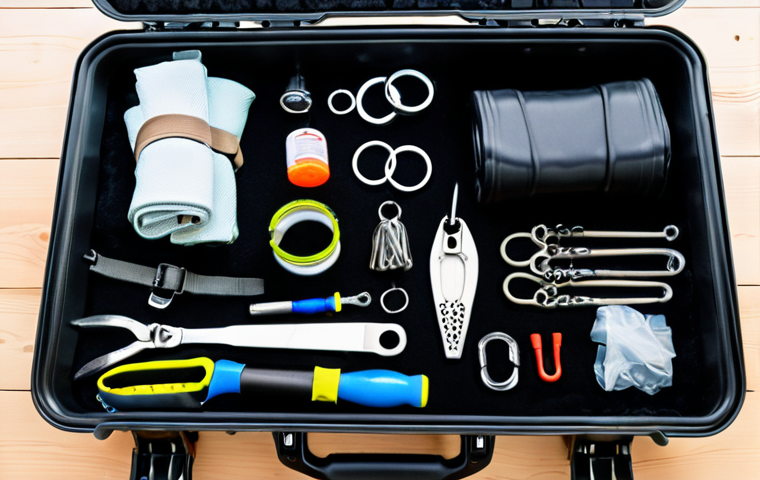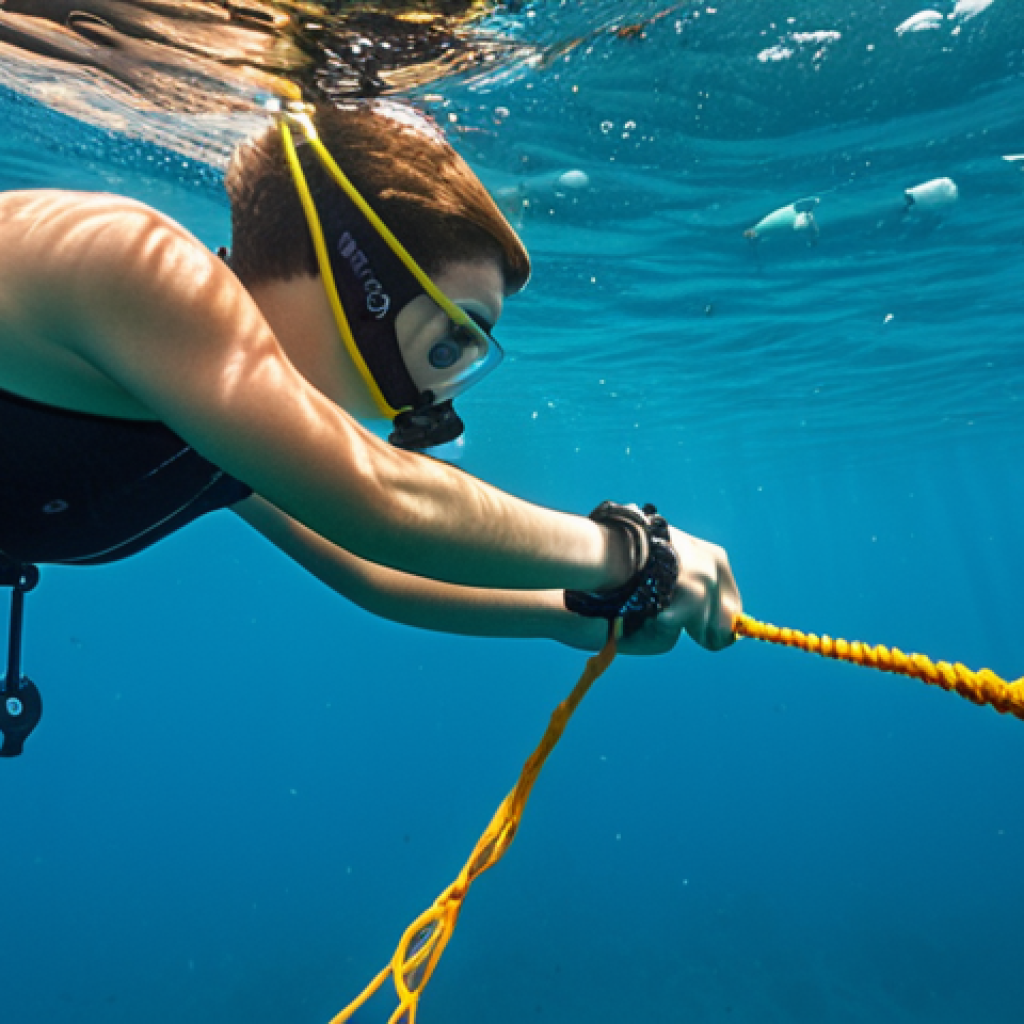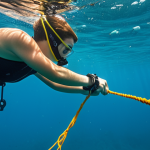So, you’re thinking about becoming a certified diving instructor? Awesome choice! It’s a rewarding path, sharing your love for the underwater world with others.
But before you can lead your first group of eager students, you need to be properly equipped. Beyond the obvious things like a mask and fins, there are a few essential items that every aspiring dive instructor should have.
I remember when I started out, feeling totally overwhelmed by all the gear I thought I needed. Don’t worry, I’ve been there! Let’s dive in and figure out exactly what you need to kickstart your journey.
Let’s uncover the essentials together in the article below!
Alright, let’s get this blog post pumping with some authentic dive instructor vibes!
1. The Indispensable Dive Instructor Toolkit: More Than Just a Mask and Fins

So you think you’re ready to teach the world to dive? Great! You’ve probably got your personal dive gear sorted, but being an instructor means you need a few extras to handle student needs and potential emergencies.
When I first qualified, I thought my personal kit was enough. Boy, was I wrong! I quickly learned that having a well-stocked toolkit is essential for being prepared and professional.
Think of it as your underwater Swiss Army knife – ready for anything!
a. The Cutting Edge: Line Cutter/Dive Knife
Never underestimate the importance of a good line cutter or dive knife. Trust me, I’ve seen divers get tangled in fishing lines, seaweed, even stray mooring ropes.
A sharp, reliable cutting tool can be a lifesaver. I personally prefer a line cutter because it’s compact and designed specifically for cutting lines quickly and safely.
Remember to keep it sharp and accessible, ideally mounted on your BCD. I actually had to use mine once to free a student who got caught on a discarded fishing net – it was a tense moment, but thankfully, we got him out quickly and safely.
b. Communication is Key: Underwater Signaling Devices
Underwater communication is vital, especially when you’re teaching. While hand signals are standard, sometimes you need something more attention-grabbing.
A good underwater signaling device, like a shaker or a horn, can be a real game-changer, especially in low visibility or when you need to get the attention of a group.
I always carry a shaker with me; it’s saved me countless times when I needed to gather my students quickly or alert them to something interesting underwater.
Plus, it’s much more effective than banging on your tank, which can scare marine life.
c. Keeping it Together: A Small Save-a-Dive Kit
Let’s face it: gear malfunctions happen. A leaky O-ring, a broken fin strap, a loose regulator hose – these small issues can ruin a dive. That’s why a small save-a-dive kit is a must-have for any instructor.
Include things like spare O-rings, fin straps, regulator mouthpieces, and basic tools like an Allen wrench and a small screwdriver. I remember one time when a student’s fin strap snapped right before our descent.
Luckily, I had a spare in my kit, and we were able to fix it in minutes and still enjoy the dive. Being able to handle minor gear issues on the spot makes you look like a pro and keeps your students safe and happy.
2. First Aid and Emergency Preparedness: Being Ready for Anything
As a dive instructor, you’re responsible for the safety of your students. That means being prepared to handle medical emergencies, both underwater and on the surface.
Having the right first aid equipment and knowing how to use it is non-negotiable. I’ve seen everything from minor cuts and scrapes to more serious issues like seasickness and even near-panic situations.
Being calm, collected, and prepared can make all the difference.
a. Oxygen Administration: The O2 Advantage
Oxygen is your best friend in a dive emergency. Knowing how to administer oxygen properly can significantly improve outcomes for divers experiencing decompression sickness or other breathing-related issues.
Invest in a good oxygen delivery system and get certified in oxygen administration. Practice regularly so you’re confident in your skills. I’ve had to use oxygen on a few occasions, and each time, it made a noticeable difference in the diver’s condition.
b. Comprehensive First Aid Kit: More Than Just Band-Aids
Your first aid kit should be more than just a collection of Band-Aids and antiseptic wipes. It should include items like sterile gloves, gauze pads, adhesive tape, antiseptic solution, pain relievers, antihistamines, and motion sickness medication.
Consider adding a CPR mask and a pocket resuscitation mask. Familiarize yourself with the contents of your kit and know how to use each item. I recommend taking a refresher course in first aid and CPR every year to keep your skills sharp.
c. Emergency Action Plan: Thinking Ahead
Before every dive, take a few minutes to review your emergency action plan. This should include things like emergency contact information, the location of the nearest medical facilities, and procedures for handling different types of emergencies.
Make sure your students are aware of the plan as well. Having a well-thought-out plan can help you respond quickly and effectively in a crisis. I always brief my students on the emergency procedures before we get in the water; it gives them peace of mind and helps them know what to expect in case something goes wrong.
3. Navigation and Orientation Tools: Don’t Get Lost!
As a dive instructor, you need to be able to navigate underwater with confidence. Getting lost or disoriented can be dangerous, especially for inexperienced divers.
Invest in some good navigation tools and practice using them regularly. I’ve been on dives where the visibility dropped to near zero, and without my compass and depth gauge, I would have been completely lost.
a. The Trusty Compass: Your Underwater GPS
A good underwater compass is essential for navigation. Learn how to use it to navigate to specific points and to maintain a consistent course. Practice using your compass in different conditions, including low visibility and strong currents.
I recommend getting a compass that’s easy to read and has a rotating bezel for setting headings. I always double-check my compass heading before starting a dive to make sure I’m on the right track.
b. Depth Gauge and Dive Computer: Keeping Track of Depth and Time
A depth gauge and dive computer are essential for monitoring your depth and dive time. These tools help you stay within safe limits and avoid decompression sickness.
Choose a dive computer that’s easy to read and has the features you need. I personally prefer dive computers with large displays and audible alarms. I always set my dive computer to be conservative; it’s better to err on the side of safety.
c. Underwater Mapping: Know Your Dive Sites
Before diving a new site, take some time to study a map of the area. This will help you understand the layout of the site and identify potential hazards.
If possible, talk to other divers who have experience diving the site. I often create my own simple maps of dive sites, noting key features like reefs, wrecks, and drop-offs.
This helps me plan my dives and guide my students more effectively.
4. Teaching Aids: Making Learning Fun and Effective
Being a good dive instructor is about more than just knowing how to dive. It’s about being able to communicate effectively and make learning fun and engaging.
Having some good teaching aids can help you explain complex concepts and keep your students interested.
a. Dive Slates: Communicating Underwater
Dive slates are essential for communicating with your students underwater. Use them to write instructions, draw diagrams, or simply ask questions. Choose a slate that’s easy to write on and erase, even when wet.
I always carry a small dive slate with me, along with a pencil that’s attached with a lanyard. I use it to give my students reminders, ask them questions, and point out interesting things underwater.
b. Visual Aids: Pictures and Diagrams
Visual aids can be a great way to explain complex concepts. Use pictures, diagrams, and videos to illustrate things like dive physics, marine life identification, and equipment operation.
You can find a wealth of resources online, or you can create your own visual aids. I often use laminated cards with pictures of common marine life to help my students identify different species.
c. Demonstration Gear: Show, Don’t Just Tell
Sometimes the best way to teach is to show, not just tell. Having some demonstration gear can help you explain how equipment works and how to perform different skills.
For example, you could use a regulator to demonstrate how to clear a flooded mask, or a buoyancy compensator to show how to control your buoyancy. I keep a spare set of dive gear specifically for demonstration purposes.
This allows me to show my students exactly how everything works without having to take apart their own gear.
5. Documentation and Professionalism: Keeping it Legit
Being a dive instructor is a professional job, and that means keeping your documentation in order and presenting yourself in a professional manner. This includes things like insurance, certifications, and student records.
Trust me, getting your paperwork sorted out early on can save you a lot of headaches down the road.
a. Insurance: Protecting Yourself and Your Students
Dive instructor insurance is essential. It protects you from liability in case of an accident or injury. Make sure you have adequate coverage and that your policy covers all the activities you’ll be engaged in.
I learned the hard way about the importance of insurance. I had a student who suffered a minor injury during a dive, and without insurance, I would have been responsible for all their medical expenses.
b. Certification Cards: Proof of Qualification
Always carry your certification cards with you. These are proof that you’re qualified to teach diving. Keep your certifications up-to-date and make sure you have any necessary endorsements.
I keep a digital copy of all my certification cards on my phone, as well as a physical copy in my dive bag.
c. Student Records: Keeping Track of Progress
Keep accurate records of your students’ progress. This includes things like their personal information, medical history, dive logs, and skill assessments.
This information is important for tracking their development and ensuring their safety. I use a simple spreadsheet to keep track of my students’ records.
This allows me to easily access and update their information.
6. Creature Comforts: Making Life Easier
While not strictly essential, there are a few creature comforts that can make your life as a dive instructor much easier. These are things that can help you stay comfortable, organized, and efficient.
a. A Good Dive Bag: Keeping Everything Organized
Invest in a good dive bag to keep your gear organized. Choose a bag that’s durable, waterproof, and has plenty of compartments for storing your equipment.
I personally prefer a rolling dive bag, as it makes it much easier to transport my gear. I also use small mesh bags to organize individual items like my mask, fins, and regulator.
b. Sun Protection: Shielding Yourself from the Elements
Spending long hours in the sun can take a toll on your skin. Protect yourself with sunscreen, a hat, and sunglasses. Reapply sunscreen regularly, especially after diving.
I always wear a rash guard and dive skin to protect my skin from the sun and from stinging marine life.
c. Hydration: Staying Refreshed
Staying hydrated is essential, especially when you’re diving in warm water. Drink plenty of water throughout the day, and avoid sugary drinks. I always carry a water bottle with me and refill it regularly.
I also like to drink electrolyte-enhanced drinks to help replenish lost fluids.
7. Maintenance and Repair Skills: Keeping Your Gear in Top Shape
Knowing how to perform basic maintenance and repairs on your dive gear can save you time and money in the long run. Learn how to inspect your gear for damage, clean it properly, and perform simple repairs like replacing O-rings and fin straps.
a. Regulator Maintenance: Breathing Easy
Your regulator is a vital piece of equipment, and it needs to be properly maintained. Learn how to inspect your regulator for damage, clean it after each dive, and have it serviced regularly by a qualified technician.
I always rinse my regulator with fresh water after each dive and store it in a cool, dry place.
b. BCD Maintenance: Staying Afloat
Your BCD is another essential piece of equipment that needs to be properly maintained. Learn how to inspect your BCD for damage, clean it after each dive, and inflate and deflate it properly.
I always rinse my BCD with fresh water after each dive and store it inflated to prevent it from sticking together.
c. Wetsuit/Drysuit Care: Staying Warm
Proper care of your wetsuit or drysuit can extend its life and keep you warm in the water. Rinse your wetsuit or drysuit with fresh water after each dive and hang it to dry in a cool, shady place.
Avoid storing your wetsuit or drysuit in direct sunlight, as this can damage the material. I also use a wetsuit shampoo to clean my wetsuit and remove any salt or bacteria.
| Item | Description | Why it’s Essential |
|---|---|---|
| Line Cutter/Dive Knife | A sharp tool for cutting lines and entanglement hazards. | Safety: Can prevent or resolve entanglement emergencies. |
| Underwater Signaling Device | A shaker or horn to get attention underwater. | Communication: Effective for group management and emergencies. |
| Save-a-Dive Kit | Spare O-rings, fin straps, tools for minor repairs. | Preparedness: Fix minor gear issues on the spot. |
| Oxygen Administration System | Equipment for administering oxygen to divers in distress. | Emergency Response: Crucial for treating decompression sickness and breathing issues. |
| Comprehensive First Aid Kit | Band-aids, antiseptic wipes, CPR mask, etc. | Emergency Response: Handle various injuries on the surface. |
| Underwater Compass | A navigational tool for maintaining direction underwater. | Navigation: Avoid getting lost in low visibility. |
| Dive Slate | A writing surface for underwater communication. | Communication: Convey instructions and questions underwater. |
Equipped with these essentials and a passion for diving, you’ll be well on your way to becoming a successful and respected dive instructor. Happy diving!
Alright, let’s wrap this up with some final thoughts and extra tidbits!
In Closing
Becoming a dive instructor is more than just a job; it’s a lifestyle. It’s about sharing your passion for the underwater world and empowering others to experience its wonders safely. Remember to always prioritize safety, stay professional, and never stop learning. The ocean is a vast classroom, and there’s always something new to discover. So gear up, get out there, and make some bubbles!
Handy Tips to Remember
1. Invest in Quality Gear: Don’t skimp on essential equipment. Quality gear lasts longer and performs better, ensuring your safety and the safety of your students.
2. Continuous Education: The diving industry is constantly evolving. Stay up-to-date on the latest techniques, technologies, and safety standards by attending workshops, seminars, and continuing education courses.
3. Build Strong Relationships: Network with other dive professionals, local dive shops, and marine conservation organizations. Building strong relationships can open doors to new opportunities and help you stay connected to the dive community.
4. Prioritize Physical Fitness: Being a dive instructor is physically demanding. Maintain a good level of physical fitness through regular exercise, healthy eating habits, and proper rest. This will help you stay energetic and alert during long days of teaching and diving.
5. Promote Marine Conservation: As a dive instructor, you have a unique opportunity to educate others about the importance of marine conservation. Lead by example by practicing responsible diving habits, supporting local conservation initiatives, and sharing your knowledge with your students.
Key Takeaways
As a dive instructor, you’re not just teaching people to dive; you’re fostering a love for the ocean and creating lifelong memories. By being prepared, professional, and passionate, you can make a positive impact on the lives of your students and the health of our marine ecosystems.
Frequently Asked Questions (FAQ) 📖
Q: Besides the basic mask and fins, what’s one piece of equipment that new dive instructors often overlook but is really important?
A: You know, from personal experience, I’d say a good underwater writing slate is often underestimated! Seriously, trying to communicate underwater without one is like trying to explain quantum physics with charades.
It’s crucial for giving clear instructions, sketching out dive plans, or even just pointing out interesting marine life. I remember one time I didn’t have mine and I was trying to explain a complicated safety procedure to a student using only hand signals – total chaos!
Get a durable one, and practice writing clearly beforehand; your students will thank you for it.
Q: I’m on a tight budget.
A: re there any essential items I can buy used to save money, or are some things better bought brand new for safety reasons? A2: Okay, being budget-conscious is smart!
I’d say you can definitely save money on things like your fins or a dive bag by buying them used. I scored an awesome dive bag for half price at a garage sale once!
However, things like your regulator and BCD (buoyancy control device) are better bought new, or at least certified pre-owned from a reputable dive shop.
Your regulator is literally your lifeline underwater, and you need to trust that it’s in perfect working order. Same goes for your BCD – you don’t want to find out it has a leak when you’re 40 feet down!
Peace of mind is worth the extra cost in those cases.
Q: What kind of professional liability insurance is generally recommended for new dive instructors?
A: Ah, insurance – the not-so-glamorous but incredibly necessary part of being an instructor! I’d highly recommend getting a policy that covers both professional liability and accident coverage.
Professional liability protects you in case a student gets injured and claims negligence. Accident coverage, on the other hand, helps with medical expenses if you get hurt while instructing.
Think of it like this: you’re teaching someone how to breathe underwater – things can go wrong, even with the best precautions. I’ve heard horror stories about instructors who skipped on insurance and ended up facing huge legal bills after a mishap.
Check with your certifying agency (like PADI or SSI); they often have partnerships with insurance providers and can get you a discounted rate. It’s a small price to pay for a lot of security.
📚 References
Wikipedia Encyclopedia
구글 검색 결과
구글 검색 결과
구글 검색 결과
구글 검색 결과
구글 검색 결과






